|
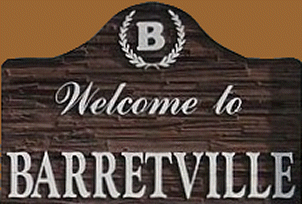
Barretville was founded in 1852 by Anthony Barret (1827-1910).
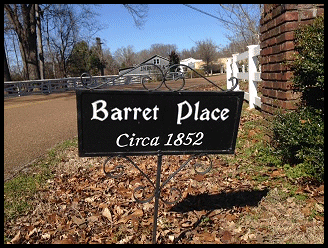 The history of Barretville is the history of the Barret family. In 1833, James Barret and his wife, Nancy, journeyed down the Mississippi River by flatboat from Kentucky to Randolph, Tennessee. They settled in the area of Portersville. They and their eight children eventually developed extensive land holdings in south Tipton and north Shelby counties. The history of Barretville is the history of the Barret family. In 1833, James Barret and his wife, Nancy, journeyed down the Mississippi River by flatboat from Kentucky to Randolph, Tennessee. They settled in the area of Portersville. They and their eight children eventually developed extensive land holdings in south Tipton and north Shelby counties.
Anthony Barret, the second son of James and Nancy Barret, moved to the area around Gratitude Church, just north of Arlington. He purchased 152 acres and the farm’s eastern portion would become known as Barretville. Anthony and Rebecca had four children (Henrietta, James, William and Walter) and built a large, white, clapboard home with a wrap-around porch.
Civil War Comes To Barretville
In 1863 a band of Confederate soldiers, comprised of Colonel John Uriah Green of the 12th Tennessee Cavalry, James Barret, Anthony Barret, John Thomson and several other Barretville area residents, had been eluding Union patrols in the Shelby County area known as Big Creek Bottom. One evening, Colonel Green and his comrades went to Anthony Barret’s home to eat supper and obtain food for their horses. A Union regiment led by Colonel Fielding Hurst of the 6th Tennessee Union Cavalry appeared suddenly and captured all of the Confederates except Thompson.
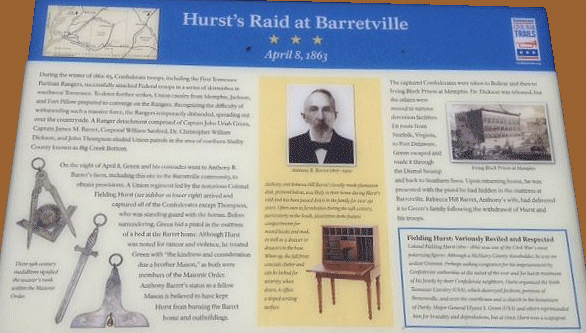
Barretville General Store
Anthony Barret opened a one-room general store in a plain wooden structure on a rise of ground close to his home near the center of his property.
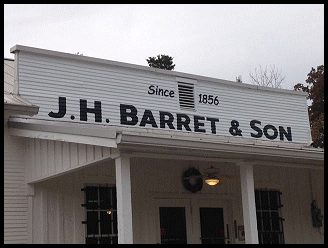 The store originally operated under the name of “Barret and Witherington,” but within a year or two, Anthony purchased the interest from his partner and changed the name to “A.R. Barret & Sons.”
In 1885 the name of the store was changed to Barretville Supply Company, to reflect the name that the settled community around the store and farm had come to be called. James Hill Barret assumed operation of the store after his father’s death in 1910, and changed the name to “J.H. Barret & Sons.” An adjustment in the company name to “J.H. Barret & Son” was made after the untimely death of James Hill’s elder son, Albert, in 1929. When James Hill Barret died in 1936, his surviving son, Paul W. Barret, retained the business’s name in tribute to his father, who had built it into a thriving enterprise of general merchandising, cotton ginning, and cotton buying. The Barret’s general mercantile store carried a wide variety of merchandise, including all types of farm hardware, clothing, shoes, and household staples. The store also housed the bookkeeper for the Barret’s businesses who also served as the local Notary Public.
For the next fifty years, Barret enterprises expanded from the general store at Barretville to include other general stores at Idaville, Kerrville, Millington, and Mudville; 3,000 acres of farmland in Shelby and Tipton counties; cotton gins at Barretville, Idaville, Kerrville, Brighton, Collierville and Atoka; a custom delinter plant; a barber shop; a beauty salon, a repair shop for automobile and farm implements; and the headquarters for Barretville Bank & Trust Company’s thirteen branch and affiliated offices covering three West Tennessee counties. Barretville Bank & Trust Company was founded in 1920 with C.C. Castles as President, J.H. Barret as Vice President, and Paul W. Barret as Cashier. J. H. Barret & Son General Store remained open under the management of the estate of Paul W. Barret until 1991, and the farm supply and fertilizer functions of the business were maintained until 1999. For more than fifty years of its 143-year operation, J.H. Barret & Son was the oldest business of its type in all of West Tennessee. Since then, the 1932 store building has housed a cidery, a restaurant, and other businesses. The store originally operated under the name of “Barret and Witherington,” but within a year or two, Anthony purchased the interest from his partner and changed the name to “A.R. Barret & Sons.”
In 1885 the name of the store was changed to Barretville Supply Company, to reflect the name that the settled community around the store and farm had come to be called. James Hill Barret assumed operation of the store after his father’s death in 1910, and changed the name to “J.H. Barret & Sons.” An adjustment in the company name to “J.H. Barret & Son” was made after the untimely death of James Hill’s elder son, Albert, in 1929. When James Hill Barret died in 1936, his surviving son, Paul W. Barret, retained the business’s name in tribute to his father, who had built it into a thriving enterprise of general merchandising, cotton ginning, and cotton buying. The Barret’s general mercantile store carried a wide variety of merchandise, including all types of farm hardware, clothing, shoes, and household staples. The store also housed the bookkeeper for the Barret’s businesses who also served as the local Notary Public.
For the next fifty years, Barret enterprises expanded from the general store at Barretville to include other general stores at Idaville, Kerrville, Millington, and Mudville; 3,000 acres of farmland in Shelby and Tipton counties; cotton gins at Barretville, Idaville, Kerrville, Brighton, Collierville and Atoka; a custom delinter plant; a barber shop; a beauty salon, a repair shop for automobile and farm implements; and the headquarters for Barretville Bank & Trust Company’s thirteen branch and affiliated offices covering three West Tennessee counties. Barretville Bank & Trust Company was founded in 1920 with C.C. Castles as President, J.H. Barret as Vice President, and Paul W. Barret as Cashier. J. H. Barret & Son General Store remained open under the management of the estate of Paul W. Barret until 1991, and the farm supply and fertilizer functions of the business were maintained until 1999. For more than fifty years of its 143-year operation, J.H. Barret & Son was the oldest business of its type in all of West Tennessee. Since then, the 1932 store building has housed a cidery, a restaurant, and other businesses.
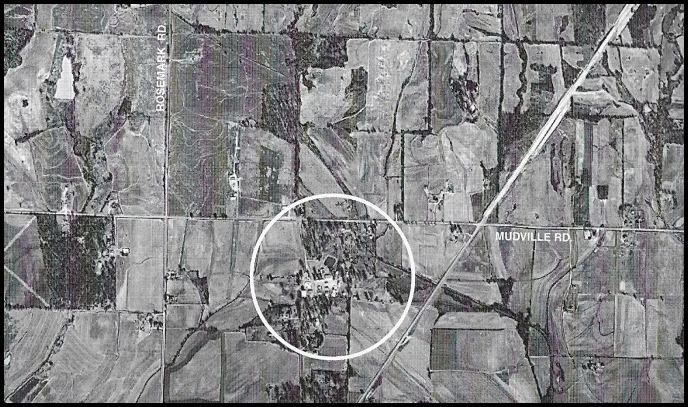
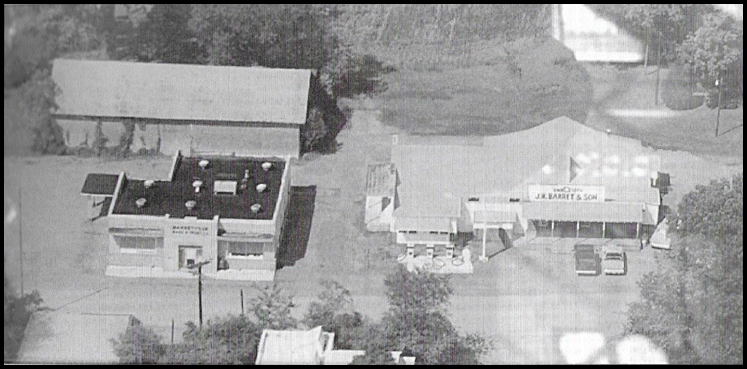
During the latter part of the 19th century and through the first half of the 20th century, Barretville was surrounded by several other communities such as Rosemark, Mudville, Stewartville, Madge and Macedonia in the northeastern portion of Shelby County, and was very close to the Tipton County line to the north. Today, Austin Peay Highway (TN 14) is a major thoroughfare leading to and from Barretville, and a 16.9-mile stretch of TN 385 (I-269) that runs west-east from Millington (TN 51) to Arlington (I-40) is named in the honor of Paul W. Barret.
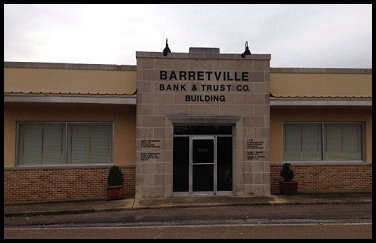
1920 |
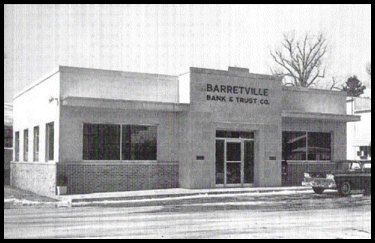
1961 |
Today the community boasts two sites on the National Register of Historic Places related to him: Squire’s Rest, his 1920 home where peacocks have roamed free since the 1940s, and the main office of Barretville Bank & Trust Co., which he co-founded in 1920. In 1931, when the bank was located immediately to the north of the present site, robbers brandishing blowtorches tried to open a safe. The ensuing blaze killed a night watchman and resulted in what was then the most extensive robbery-arson-murder trial in Shelby County history. Barretville Bank was designated one of the largest rural banks in the U.S. in the 1940s and one of the safest banks in the U.S. in the 1970s.
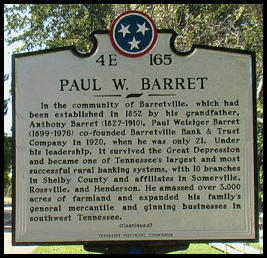
In the community of Barretville, which had been established in 1852 by his grandfather, Anthony Barret (1827-1910), Paul Weisiger Barret
(1899-1976) co-founded Barretville
Bank & Trust Company in 1920, when
he was only 21. Under his
leadership, it survived the Great
Depression and became one of
Tennessee’s largest and most
successful rural banking systems,
with 10 branches in Shelby County
and affiliates in Somerville,
Rossville, and Henderson. He amassed
over 3,000 acres of farmland and
expanded his family’s general
mercantile and ginning business in
Southwest Tennessee. |
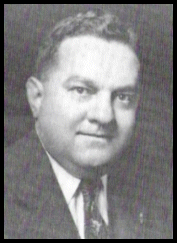
Paul W. Barret
(1899-1976) |
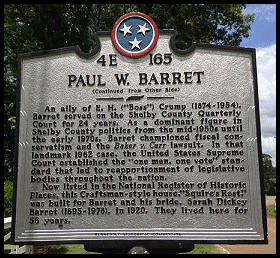
An ally of E.H. (“Boss”) Crump (1874-1954), Barret served on the Shelby County Quarterly Court for 24 years. As a dominant figure in Shelby County politics from the mid-1950s until the early 1970s, Barret championed fiscal conservation and the Baker v. Carr lawsuit. In that landmark 1962 case, the United States Supreme Court established the “one man, one vote” standard that led to reapportionment of legislative bodies throughout the nation. Now listed in the National Register of Historic Places, the Craftsman-style house, “Squire’s Rest,” was built for Barret and his bride, Sarah Dickey Barret (1895-1978), in 1920. They lived here for 56 years. |
Barret Gin Company had cotton gin operations in Barretville, Idaville, Kerrville, Brighton, Collierville and Atoka. The compound in Barretville was comprised of 11 buildings including a linter house (A on below diagram), scale house or weigh house (B), two warehouses (C), the cotton gin (D), seed house (E) and five residential dwellings (F, G, H, I, J) for employees and family members. Most cotton gins sent their cotton seed to Buckeye Cotton or Memphis Cotton Oil, Inc. The Barretville Gin had a Linter House and a delinter.
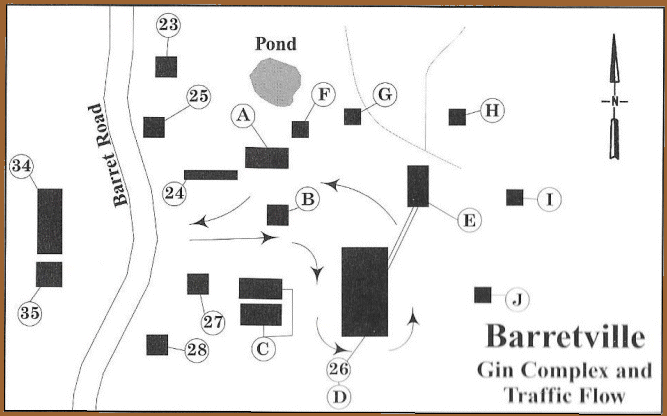
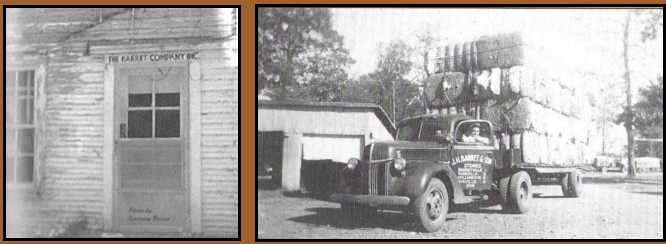
A large Scale platform was located adjacent to a small wooden structure, the truck or wagon on which the cotton was brought to the gin would be driven onto the scale and weighed. Later the empty truck or wagon was brought back and re-weighed. The difference resulted in the weight of the “seed cotton” to be processed through the gin. The two Warehouses were used for storage of equipment and materials. The Seed House received the cotton lint through a metal tube after it was separated from the cotton seed. The Gin constituted the heart of the complex cotton processing operation. Bales of cotton were loaded onto trucks from a large concrete ramp on the north side of the gin.
Bobby Blue Bland (1930-2003), who grew up in Barretville, was hailed by the New York Times as “a debonair balladeer” who helped modernize the blues. Because his grandmother disapproved of the blues, as a youngster Bland sang mostly church music and country music. Tunes of the latter sort earned him as much as 50 cents per song from wagon drivers waiting to unload cotton at the Barret Gin on the east side of Barret Road.
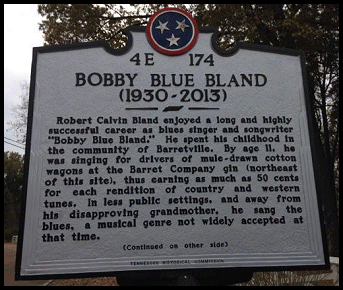
Robert Calvin Bland enjoyed a long and highly successful career as blues singer and songwriter “Bobby Blue Bland.” He spent his childhood in the community of Barretville. By age 11, he was singing for drivers of mule-drawn cotton wagons at the Barret Company gin (northeast of this site), thus earning as much as 50 cents for each rendition of country and western tunes. In less public settings, and away from his disapproving grandmother, he sang the blues, a musical genre not wildly accepted at that time. |
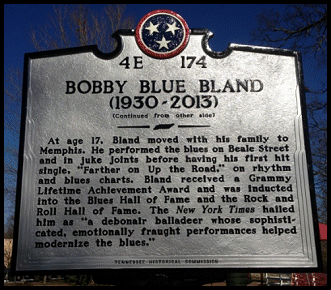
At age 17, Bland moved with his family to Memphis. He performed the blues on Beale Street and in juke joints before his first hit single, “Farther Up The Road,” on rhythm and blues charts. Bland received a Grammy Lifetime Achievement Award and was inducted into the Blues Hall of Fame and Rack and Roll Hall of Fame. The New York Times hailed him as “a debonair balladeer whose sophisticated, emotionally fraught performances helped modernize the blues.” |
Bobby Blue Bland was nominated for seven Grammy Awards in the course of his career. He received the following honors: Blues Hall of Fame - inducted 1981, Rhythm and Blues Pioneer Award – 1992, Rock and Roll Hall of Fame - inducted 1992, Grammy Lifetime Achievement Award – 1997, Grammy Hall of Fame - "Turn On Your Lovelight" (1999), Memphis Music Hall of Fame - inducted 2012.
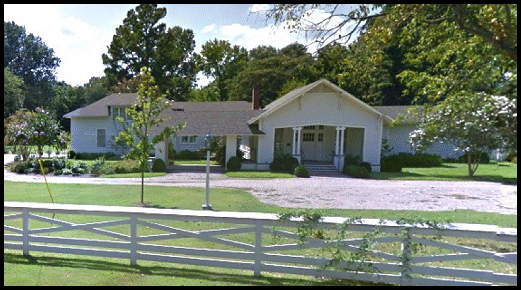
Squire’s Rest, the home of Paul W. Barret, was placed in the National Register of Historic Places on May 31, 2007. Squire’s Rest was built for newlyweds Paul and Sarah Barret in 1920, the Barret Homestead or Squire’s Rest is a one-story craftsman cottage significant for its relation to the life of Paul Barret. He is credited with creating The Barret Company, a dealer in cotton, and expanding his father’s chain of cotton gins to six, spanning 6 different towns throughout West Tennessee, including Collierville. He also owned and operated J. H. Barret & Son General Store, founded in 1856 by his grandfather, and saw it through its 100th anniversary. His most notable business success was as a banker through his association with Barretville Bank & Trust Co., which he co-founded in 1920 and where he worked for 55 years. The Barretville Bank & Trust was one of the few banks in the area that survived the Great Depression, outlasting the Bank of Millington and Arlington Bank & Trust Co. Paul Barret was also active in Edward Hull “Boss” Crump’s political organization, and maintained a great deal of political power after Crump’s death. He “held public office continuously for over 40 years and won every elective office for which he was a candidate,” including Shelby County Board of Education chairman, Circuit Court Clerk, and Shelby County Quarterly Court Squire.
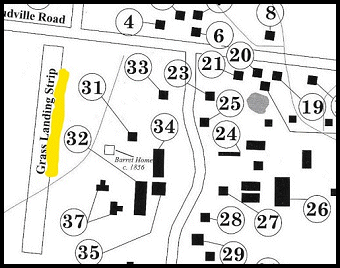
Barret Airport on Mudville Road 1954 |
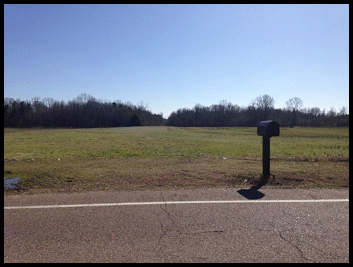
Former Site of Barret Airport on Mudville Road 2020 |
|
 |
Barretville
was also locally known for its once
large number of domesticated
peafowl, originally cared for by
Sarah Louisa Barret. Today, there are two male “peacocks” (female called “penhens”), whose names are George and Charles. |
 |
On the north and south side of Pleasant Union Cumberland Presbyterian Church are situated two cemeteries – Rosemark Cemetery and Mudville Cemetery. Located on the north side, the cemetery known as both Mudville and Pleasant Union has been in existence since the mid-1880s. The church and cemetery separated themselves legally and financially several years ago, and the cemetery assumed the name Mudville Cemetery.
Rosemark Cemetery was established in 1909. The initial cemetery property was deeded to Richland Associate Reformed Presbyterian Church in 1907. Prior to the development of the cemetery, Rosemark residents and church members were most often buried in either private family cemeteries, Salem A.R.P. Cemetery or in the Mudville Cemetery. A cemetery committee recommended the purchase of two acres just south of Pleasant Union Church on Brunswick Road. A plat was drawn by T.C. McQuiston on linen cloth, and that drawing remains in the hands of those who oversee the cemetery. In 1976, a perpetual care fund was established and is managed through Richland A.R.P. Church.
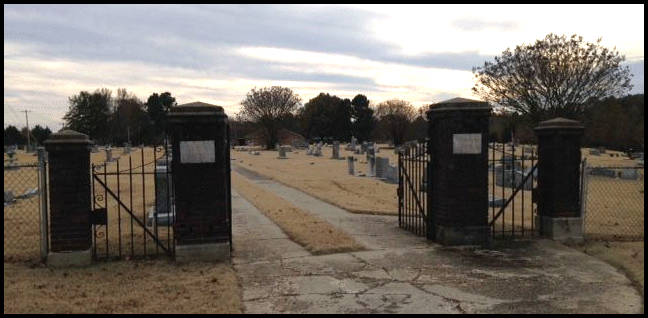
Later Anthony Chapel School was built in the area, west of Brunswick Road and just north of Mulberry Road, to educate African-American children from Mudville, Barretville and Rosemark. In May, 2015, a historical marker was dedicated by Historic Archives of Rosemark and Environs, Inc. and the Shelby County Historical Commission stating:
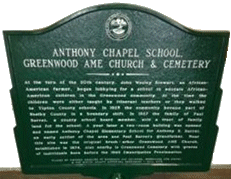 Anthony Chapel School, Greenwood AME Church & Cemetery. At the turn of the 20th century, John Wesley Stewart, an African-American farmer, began lobbying for a school to educate African-American children in the Greenwood community. At the time the children were either taught by itinerant teachers or they walked to Tipton County schools. In 1925 the community became part of Shelby County in a boundary shift. In 1927 the family of Paul Barret, a county school board member, sold a tract of family land for the school. A year later a two-room building was opened and named Anthony Chapel Elementary School for Anthony R. Barret, an early settler of the area and Paul Barret’s grandfather. Near this site was the original brush-arbor Greenwood Cemetery with graves of individuals born before the 1865 Emancipation Proclamation. Anthony Chapel School, Greenwood AME Church & Cemetery. At the turn of the 20th century, John Wesley Stewart, an African-American farmer, began lobbying for a school to educate African-American children in the Greenwood community. At the time the children were either taught by itinerant teachers or they walked to Tipton County schools. In 1925 the community became part of Shelby County in a boundary shift. In 1927 the family of Paul Barret, a county school board member, sold a tract of family land for the school. A year later a two-room building was opened and named Anthony Chapel Elementary School for Anthony R. Barret, an early settler of the area and Paul Barret’s grandfather. Near this site was the original brush-arbor Greenwood Cemetery with graves of individuals born before the 1865 Emancipation Proclamation. |
Greenwood Church originated as a brush-arbor church north of Mulberry Road in either 1874 or 1878.
A wood frame building which faced the east was constructed. At that time, Mulberry Road was a dirt road and the road to the church was a steep trail. Due to the difficulty of reaching the church grounds, the building was torn down in 1924 and the lumber was used to construct a new church at the current site of the Greenwood A.M.E. Church at 8017 Donnell Road, a more accessible location.
Barret’s Chapel School - Barret’s Chapel High School, located at 1020 Godwin Road, dates to the late 1870s. Residents of northeast Shelby County, including newly-freed slaves, petitioned Squire Henry Thomas, Director of Shelby County Schools, for school to accommodate the children in the area. Land was given by Mrs. Jane Hays, and a one-room school was built and named Hays Grove in honor of the donor. According to school history, Hays Grove was the first school in Shelby County to hold an eighth grade graduation exercise for black students. Later, with assistance from the Rosenwald Fund, a four-room school was built. Miss Vivian Bolton was the first principal of that school.

In 1922
additional land was purchased for and an eight-room building with an auditorium was built to accommodate twelve grades. The name was changed to Barret’s Chapel in recognition of J.H. Barret for his leadership in establishing the high school. In the spring of 1960, a fire destroyed all buildings on the campus except the high school building, vocational shop, and the principal’s home. The construction of a new cafeteria, gymnasium, and elementary was completed in 1961. Desegregation of schools in Shelby County during the 1960s brought many changes. In May 1971, the last senior class graduated. Barret’s Chapel became a K-8 school with the 1971-72 school term.
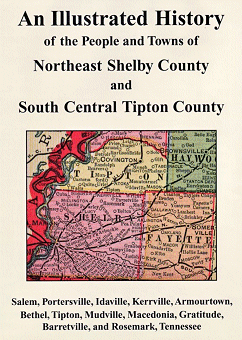 |
Excerpts from the jacket of An Illustrated
History of the People and Towns of Northeast
Shelby County and Southeast Tipton County by
Historic Archives of Rosemark and Environs (H.A.R.E.):
On October 19, 1818, the United States Congress
ratified the treaty with the Chickasaw Nation
ceding West Tennessee to the United States. What
followed was the creation of Shelby County
in1819 and, to its north, the creation of Tipton
County in 1823. Settlers followed quickly. Along
the border of Shelby and Tipton counties small
communities developed around churches, schools,
and country stores. This is the story of the
people who have lived there. Over the last 180
years most of the schools and some of the towns
of Northeast Shelby County and South Central
Tipton County have disappeared. The churches and
cemeteries remain and the land is still farmed.
This illustrated history attempts to capture the
stories of those people and places where they
lived. Through a series of articles and
interviews, maps, photographs, diaries, and
letters, you can experience the people who lived
on the farms and worked in the towns of Salem,
Portersville, Idaville, Kerrville, Armourtown,
Bethel, Tipton, Mudville, Macedonia, Gratitude,
Barretville, and Rosemark. |
 On June 14, 2013 the Rosemark Historic
District was placed in the National and
Tennessee Registers of Historic Places by
the National Park Service the United States
Department.
On June 14, 2013 the Rosemark Historic
District was placed in the National and
Tennessee Registers of Historic Places by
the National Park Service the United States
Department.
The Historic Archives of Rosemark and
Environs is a non-profit organization whose
mission is to document & preserve historic
information & items of the Rosemark region
for educational purposes. It is primarily
responsible for the creation of the Rosemark
Historic District. Please consider a tax
deductible contribution to help them
continue these efforts.
For more
information about H.A.R.E.
www.rosemarkhistoricdistrict.com
Or, on Facebook at
www.facebook.com/RosemarkHistoricDistrict
|